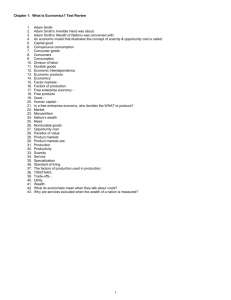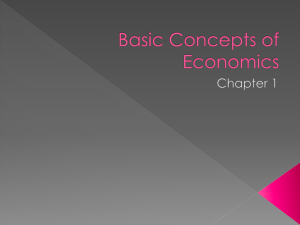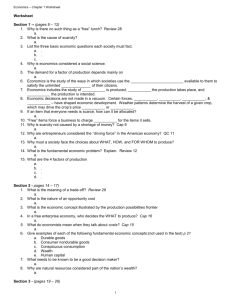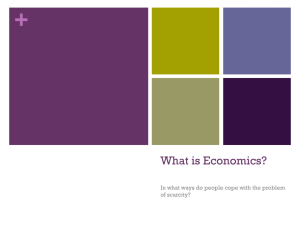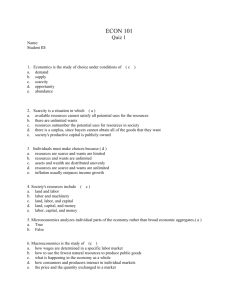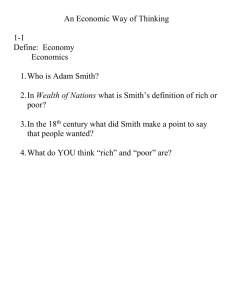Fundamental Economic Concepts
advertisement
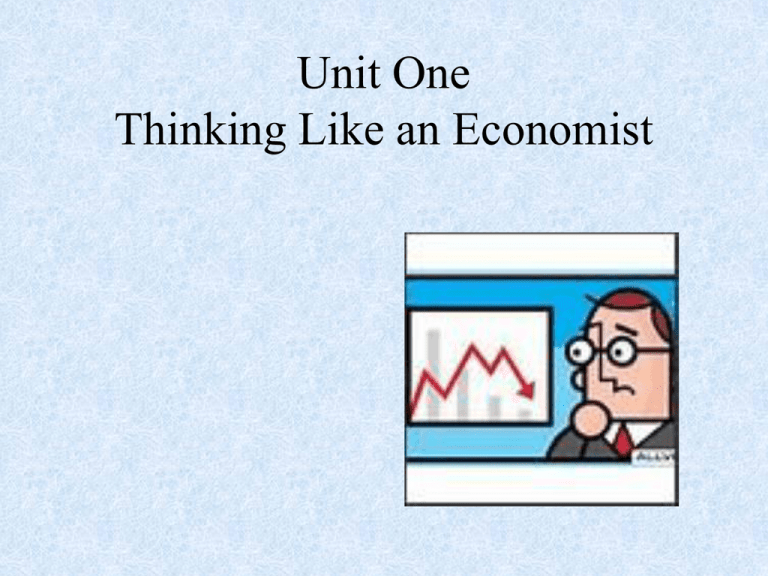
Unit One Thinking Like an Economist Fundamental Economic Concepts Chapter One What is Economics? The Study of how people try to satisfy what appears to be seemingly unlimited and competing wants through the careful use of relatively scarce resources. Do you think the study of economics is worth your time and effort? 1. Go to page 3, examine the picture – How does this image symbolize the chapter titled What is Economics? 2. Imagine you have $100 to spend – make a list of items that you would like to buy and the approximate price of each. Add up the total – did you go over a $100? If so you will need to remove something from your list Choice is the Key concept in Economics! Scarcity and the Science of Economics Lesson 1 Go to page 6 and Complete the Scarcity activity. What is the most fundamental economic problem facing all societies? SCARCITY The condition that results from society not having enough resources to produce all the things people would like to have. Do you know the difference between a need and a want? Need – is a basic requirement for survival – food, clothing, shelter Want – is a way of expressing a need – example – for food a person may “want” pizza Economic Products – goods and services that are useful, relatively scarce, and transferable to others. Good – an item that is economically useful or satisfies an economic want -Durable and Nondurable goods Project information Make a Collage • Divide your paper in half • Label one side “Durable Goods” and the other side “Nondurable Goods.” • Collect 6 pictures to use as example for each side • Graded on : • Following Directions: 5 points • Durable Goods: 15 points • Nondurable Goods: 15 points • Neatness/Name/Title: 5 points • Turned it on Time: 10 points • Total: 50 points Adam Smith pg. 9 1. Adam Smith is considered the _______________. 2. What is the name of his book and in what year was it written? 3. Smith believed that political economics depends on a __________________. 4. What did Smith mean by “Invisible Hand”? 5. What type of capitalist system did Smith support? Important Economic Terms Consumer Good – use by individuals Capital Goods – used to produce other goods Services – work that is performed Consumers – one who uses goods and services Value – refers to a worth that can be expressed in dollars and cents Paradox of Value - what makes something valuable? Utility – the capacity to be useful and provide satisfaction Wealth – accumulation of products What is TINSTAAFL? THERE IS NO SUCH THING AS A FREE LUNCH Three Basic Questions • What to produce? • How to Produce? • For Whom to Produce? The Scope of Economics • Description - Gross Domestic Product (GDP) • Analysis • Explanation • Prediction Copy and answer the following questions: 1. What is the basic economic problem facing all societies? 2. How is need different from want? 3. What do the letters TINSTAAFL stand for, and what does the term mean to consumers? 4. What are the three basic questions societies have to answer about the way their resources are used? 5. What are the four key elements of the study of economics? Explain briefly why each one is important. 6. What is scarcity in an economic sense? 7. What is the difference between a consumer good and a capital good? 8.What kind of economic product is a service? 9.What is a consumer? 10.To what does value refer? 11. What is the paradox of value? 12.What is required for something to have value? 13.What is wealth?, List the four characteristics of the accumulated goods that make up economic wealth. 14. Define GDP Our Economic Choices Sec. 2 Think of the economy as two broad groups: Producers and Consumers Complete activity on page 14 Factors of Production • Land – natural resources • Capital – tools, equipment, machinery and factories used in production (Capital Goods) (Financial Capital) • Labor - workers • Entrepreneurs – risk takers Equals – Production – the process of producing goods and services Production Possibilities Curve • Identifying Possible Alternatives • Fully Employed Resources • Opportunity Cost – the value of the next best alternative given up • The Cost of Idle Resources • Economic Growth There are alternatives and costs to everything we do. In a world where “TINSTAAFL”, it pays to examine these concepts closely. TRADE –OFFS or alternative choice – figure 1.5 - discuss OPPORTUNITY COST – the cost of the next best alternative use of the money, time, or resources when one choice is made rather than another Consumer Rights • • • • • The right to safety The right to be informed The right to choose The right to be heard The right to redress Consumerism - a social movement that aimed at promoting the interests of consumers Complete sec. 2 handout Using Economic Models sec. 3 Because resources are scarce, consumers need to make wise choices. Economic Growth • When a nation’s total output of goods and services increase over time Economics growth requires risks and sacrifices. Economic Growth – occurs when a nation’s total output of goods and services increases over time The most important factor to Economic Growth is Productivity Productivity – measure of the amount of output produced by a given amount of inputs in a specific period of time Division of Labor – workers are arranged so that individual workers do fewer task Specialization – when a worker does one task and does it well Human Capital – the sum of the skills, abilities, health, and motivation of people The Circular Flow of Economic Activity • Factor Market – the market where productive resources are bought and sold • Product Markets – market where producers sell their goods and services to consumers Draw the chart on page 25 and answer the questions under the chart - turn in for a grade Economic Interdependence We rely on others, and others rely on us to provide the goods and services that we consume Thinking Like an Economist • Build Simple Models • Employ Cost-Benefit Analysis –compare the cost of an action to the benefits received • Take Small, Incremental Steps The Road Ahead • Understanding the FREE ENTERPRISE ECONOMY- one in which consumers and privately owned business, rather than the government, make the majority of the WHAT, HOW, & FOR WHOM decisions • STANDARD OF LIVING – the quality of life based on the possession of necessities and luxuries that make life easier • Economics for Citizenship • Making the Rational Choice Chapter 1, sec. 3, pg. 29 Answer questions 2 – 6 Chapter 1, Assessment– 33 Answer # 1 - 15 Turn in for a grade Chapter 1 test on 8/18
